Education is the strongest socio-economic predictor of smoking in pregnancy
Noora M. Scheinin; Hasse Karlsson; Matti Lindberg; Linnea Karlsson; Juho Härkönen
https://urn.fi/URN:NBN:fi-fe2021042718816
Tiivistelmä
Aims To investigate socio-economic disparities in smoking in pregnancy (SIP) by the mother’s education, occupational class and current economic conditions. Design Cross-sectional analysis with linked survey and register data. Setting South-western Finland. Participants A total of 2667 pregnant women [70% of the original sample (n = 3808)] from FinnBrain, a prospective pregnancy cohort study. Measurements The outcome was smoking during the first pregnancy trimester, measured from the Finnish Medical Birth Register. Education and occupational class were linked from population registers. Income support recipiency and subjective economic wellbeing were questionnairebased measures of current economic conditions. These were adjusted for age, partnership status, residential area type, parental separation, parity, childhood socio-economic background, childhood adversities (the Trauma and Distressing Events
During Childhood scale) and antenatal stress (Edinburgh Postnatal Depression Scale). Logistic regressions and attributable fractions (AF) were estimated. Findings Mother’s education was the strongest socio-economic predictor of SIP. Compared with university education, adjusted odds ratios (aORs) of SIP were: 2.2 [95% confidence interval (CI) = 1.2–3.9; P = 0.011] for tertiary vocational education, 4.4 (95% CI = 2.1–9.0; P < 0.001) for combined general and vocational secondary education, 2.9 (95% CI = 1.4–6.1; P = 0.006) for general secondary education, 9.5 (95% CI 5.0–18.2; P < 0.001) for vocational secondary education and 14.4 (95% CI = 6.3–33.0; P < 0.001) for compulsory schooling. The total AF of education was 0.5. Adjusted for the other variables, occupational class and subjective economic wellbeing did not predict SIP. Income support recipiency was associated positively with SIP (aOR = 1.8; 95% CI = 1.1–3.1; P = 0.022). Antenatal stress predicted SIP (aOR = 2.0; 95% CI = 1.4–2.8; P < 0.001), but did not attenuate its socioeconomic
disparities. Conclusions In Finland, socio-economic disparities in smoking in pregnancy are attributable primarily to differences in the mother’s educational level (low versus high) and orientation (vocational versus general).
Kokoelmat
- Rinnakkaistallenteet [19207]
